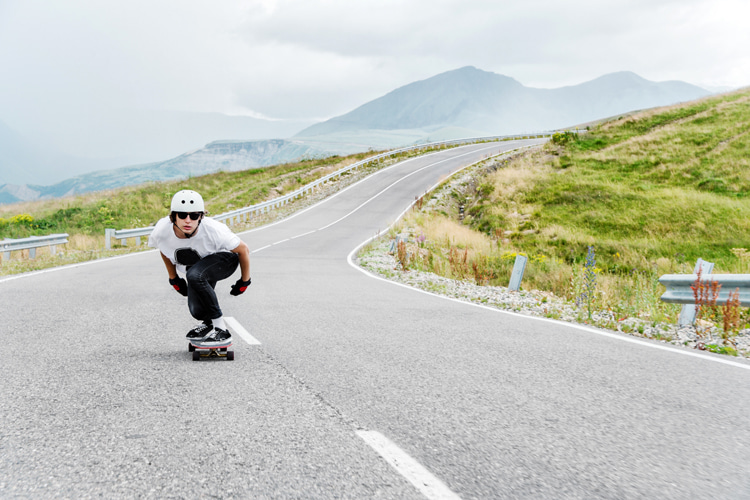Over the past several years, longboarding has exploded in popularity.
The reasons are many, but the bottom line is that longboarding appeals to many people because anyone can pick up and learn to ride, regardless of age or skill level.
A large portion of the growth is due to the advantages of a longboard while commuting.
A longboard has larger, softer wheels that roll longer and smoother, giving a much different ride than a typical street board.
The other major advantage is that a longboard is much less bulky than a bike, meaning it can be taken onto buses, the subway, and even into class.
The other areas of the sport that have grown rapidly are downhill and freeriding.
With all the recent developments in gear, riders are now doing things that would have been previously thought impossible on a longboard.
As you get better acquainted with the world of longboarding, you'll soon discover a wide range of products that provide different riding experiences.
We encourage you to try these various setups.
Eventually, you'll find yourself building a quiver of boards. Then, no matter the type of terrain you find yourself on, you'll have the right longboard.
Enjoy this guide, and remember always to put safety first.

Longboarding Disciplines
Carve/Cruise/Commute
Carving and cruising are the most widespread forms of longboarding.
It is more about using a longboard as a fun way to commute from point A to B rather than seeing how fast you can go.
The greatest thing about carving up the asphalt with a longboard is that you don't need surf, snow, or even a lift ticket.
You just open up your door and go.
Freeriding/Sliding
Freeriding takes things up a notch from merely cruising or carving.
Freeriding usually keeps the rider going slower than straight bombing a hill. It is about flow and style and performing every type of slide possible.
Freeride boards are usually set up to turn a lot and slide easily.
They feature symmetrical shapes most of the time for riding switch (riding backward with the tail facing downhill) and are usually set up with round lip wheels to help the board get sideways.
Downhill
Downhill racing is about being the first person to the bottom of the hill and ensuring you have a lot of fun doing it.
You need a deck that is stable at high speeds with no flex. It's also vital that you wear all safety gear - not just a helmet.
Most serious downhillers have a full leather suit.
Slalom
While technically not a longboard, slalom has carved out its own place within the world of longboarding.
The reason is simple.
If you love speed and the feeling of carving with precision, then you'll enjoy whipping through cones.
Slalom has deep roots within skateboarding, and thanks to cutting-edge technology, there is a whole new generation of coneheads out there.
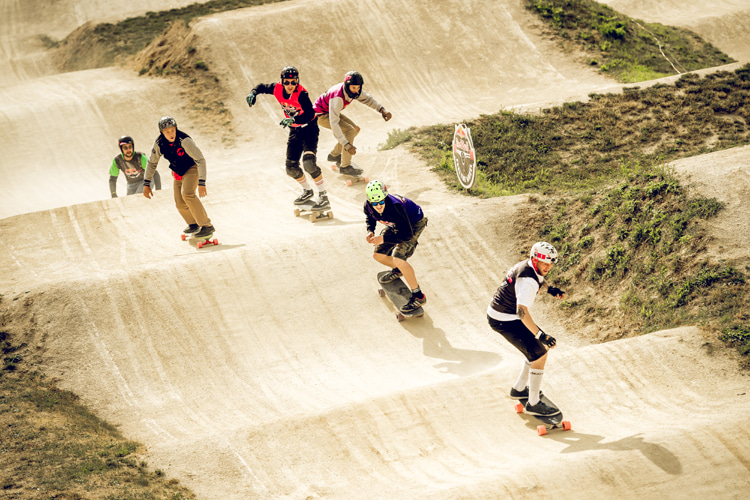
Types of Longboards
What is a top mount longboard?
It's the simplest of all mounting styles - the board sits atop the trucks like on a normal skate deck.
The advantages of a top mount come because it keeps the rider's weight and feet over the wheels.
It allows the rider to have maximum control and leverage over the trucks.
Top mounts have emerged lately, especially smaller ones with a shorter wheelbase.
Top mounts function as great downhill race boards because of the grip, but people have been using them for freeride lately, which is also popular.
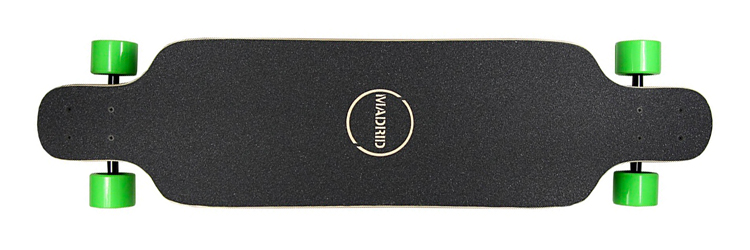
What is a dropped or drop-down longboard?
A dropped - or drop-down - board means the riding platform (the part of the deck the rider stands on) is sunk below the trucks.
It's not to be confused with the drop-through mounting, although it creates a similar feeling by lowering the ride height to help riders feel locked in.
Dropped boards are better for pushing because you're lower to the ground and for freeriding because they slide longer because of the lower center of gravity.
A dropped board will still function great for downhill, too.
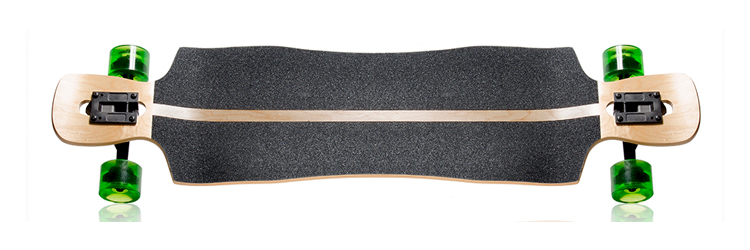
What is a drop-through longboard?
Drop-through mounting lowers the ride height similar to a dropped board but differently.
A drop-through board is machined out, so the trucks mount from the top. It is done by separating the hanger from the base plate.
You then mount the base plate into the board from the top, followed by the hangar from underneath.
Drop-through boards tend to come mostly symmetrical in shape so riders can ride better in a switch stance.
Usually sits around 0.5-1'' lower when mounted in a drop-through style, making the board more drifty and good for sliding.
I want a board that is fun to cruise on. What should I be looking for?
Longboards come in many different shapes and styles but also different thicknesses and materials.
As a general rule, if it has a lot of flex, the board was designed more to carve and cruise.
Flex in the board allows for a snappy, quick feeling of carving and is great for commuting, bobbing, and weaving between people on a sidewalk.
Most boards that feature flex are made of bamboo or a bamboo composite combination.
Boards are usually offered with different flex levels so they can be tailored to the person's weight and preference.
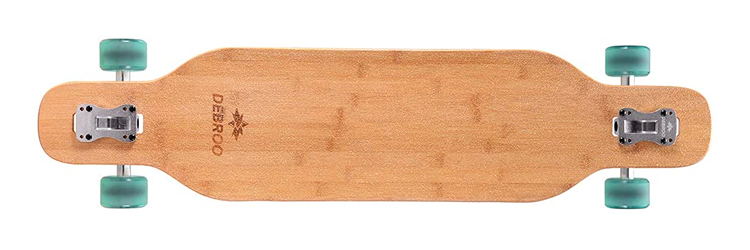
Longboard Materials
Maple
Maple is probably the most common board material because of its availability, price, and durability.
Maple creates a very stiff feeling board because of its rigidity and thickness.
A maple board will also last an extremely long time and should be able to hold up to even the hardest of skateboarding.
Bamboo
Bamboo is becoming a more common board-building material in the longboard world.
Bamboo has much more flex and resilience than maple. Bamboo boards are more for carving and cruising because they have so much flex.
Bamboo is usually used with fiberglass to help hold the board together under the stress of a skater.
A bamboo board is usually not very thick compared to a maple deck, but this creates a board that is easier to carry around when not in use.
Carbon Fiber
Carbon fiber is the most expensive option for a longboard composite, but it brings advantages to the table.
Carbon boards are very light and usually have a foam core to help lighten the weight.
Carbon is usually used to wrap another medium to make it stronger; a lighter board makes for a faster push off the start line and makes it easier to move around in slides.
Carbon fiber is more for an experienced rider because it takes time to learn a board well enough to appreciate the feel of carbon fiber.
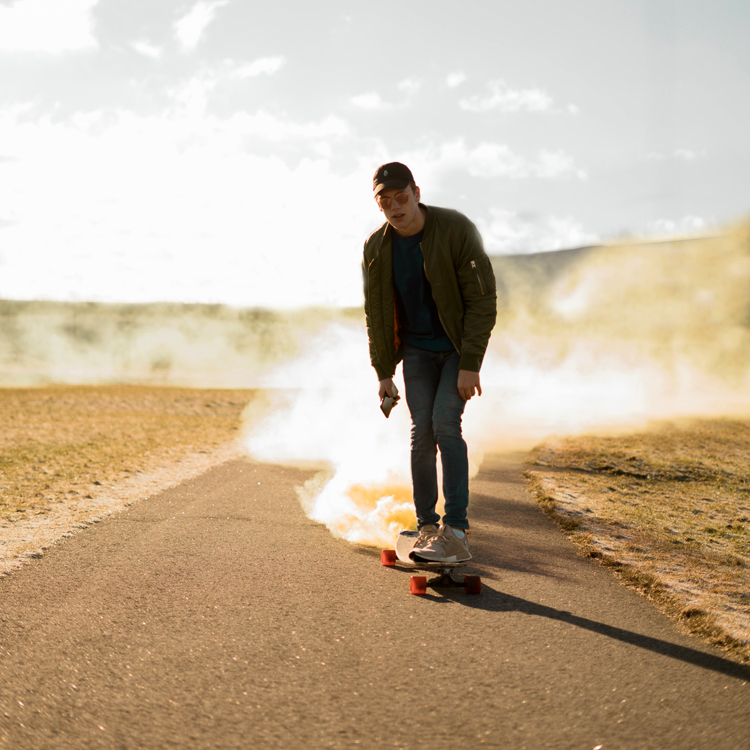
Longboard Gear and Design
Trucks
Longboard trucks are very different than regular street skating trucks.
A longboard truck is known as a "reverse kingpin" truck because the axle is on the other side of the kingpin compared to a standard truck.
A longboard truck has lots of lean, creating deep, smooth-feeling carves that longboarders crave.
Reverse kingpin trucks are affected by many factors, and knowing which trucks will go well with which board and style of riding is the key to a proper setup.
Hangar Width
You must first consider several things when selecting which truck is right for which board.
The first of these is the width of the hanger. The hanger width is supposed to match the width of the board.
A 9'' wide deck or greater will need a minimum of 180 mm hanger width.
With less hanger width, the wheels are more likely to come into contact with the board during sharp turns and stop suddenly because of wheel bite.
Decks that are not as wide can get away with the sharper turning 150 mm trucks as they are designed more for smaller cruising boards and minis.
Baseplate Angle
Base plate angle also affects how a truck turns; a lower base plate angle will make the truck turn less, while a higher angle will allow for more turn.
A 50* Base plate will also make the setup slightly taller than 40-45* baseplates. A 50* base plate is the standard for longboarding.
Fifty degrees is a great all-around base plate because it turns enough for cruising but still has some stability for downhill.
At the same time, a lower angle will be better for stability because it has less ability to turn.
It works great for downhill but can take away some of the fun of a board when it doesn't turn sharply for cruising.
Most downhillers will run a 42* or 44* base plate with a 180 mm hanger.
Wheels
The magic of longboarding comes together with the wheels.
You must utilize the correct wheels because they can make a huge difference in your riding experiences.
Durometer is a measurement system for urethane that measures its hardness. The lower the number, the softer the wheel will be.
An extremely soft wheel will grip the pavement better through turns because the urethane is stickier, although they may roll slightly slower and not slide as smoothly because they are soft.
A hard longboard wheel will be around an 83-86 durometer. These wheels will roll faster, grip less, and chatter less in slides.
The reason is that a harder wheel has a higher roll speed and less rippling in the urethane when sliding.
Wheel Shape
Wheels that have rounded edges are usually designed as freeride/sliding-based wheels.
A rounded lip allows the wheel to break sideways into slides more easily, which is what someone interested in sliding and learning to slide is looking for.
Rounded lips tend not to be as good as a racing wheel because the rounded edges don't promote grip through turns.
A rounded lip wheel will work well for a person who is commuting as they don't need lots of grip.
Wheels with sharper edges rather than smooth, round lips are traditionally designed for maximum grip and racing.
A hard-lipped wheel doesn't break traction as easily as its slippery counterparts.
That doesn't mean that wheels with hard lips can't slide or be used for freeriding. They are just harder to break into a slide.
Hard-lipped wheels are great for racers who will know exactly which model and hardness they would like.
The Wheel Bite
It happens when a turn causes a wheel to collide with the board, usually resulting in the board suddenly stopping.
It's something that you should test for before riding any board.
There are a few ways to prevent this from happening.
The simplest is to keep the kingpin tight enough to prevent the hanger from leaning far enough for it to bite.
The other easy solution is having a few risers between the trucks and the deck. You can also purchase smaller wheels.
Words by Michael Brooke | Skateboarder and Author of "The Pocket Guide to Longboarding"
